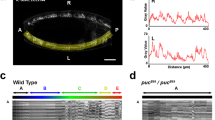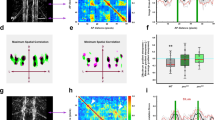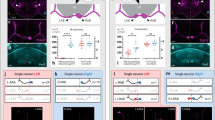Abstract
Precise patterning of dendritic fields is essential for neuronal circuit formation and function, but how neurons establish and maintain their dendritic fields during development is poorly understood. In Drosophila class IV dendritic arborization neurons, dendritic tiling, which allows for the complete but non-overlapping coverage of the dendritic fields1,2,3, is established through a ‘like-repels-like’ behaviour of dendrites mediated by Tricornered (Trc), one of two NDR (nuclear Dbf2-related) family kinases in Drosophila4,5,6,7. Here we report that the other NDR family kinase, the tumour suppressor Warts/Lats (Wts)8,9,10, regulates the maintenance of dendrites; in wts mutants, dendrites initially tile the body wall normally, but progressively lose branches at later larval stages, whereas the axon shows no obvious defects. We further provide biochemical and genetic evidence for the tumour suppressor kinase Hippo (Hpo)11,15 as an upstream regulator of Wts and Trc for dendrite maintenance and tiling, respectively, thereby revealing important functions of tumour suppressor genes of the Hpo signalling pathway in dendrite morphogenesis.
This is a preview of subscription content, access via your institution
Access options
Subscribe to this journal
Receive 51 print issues and online access
$199.00 per year
only $3.90 per issue
Buy this article
- Purchase on Springer Link
- Instant access to full article PDF
Prices may be subject to local taxes which are calculated during checkout




Similar content being viewed by others
References
Wässle, H., Peichel, I. & Boycott, B. B. Dendritic territories of cat retinal ganglion cells. Nature 292, 344–345 (1981)
MacNeil, M. A. & Masland, R. H. Extreme diversity among amacrine cells: implication for function. Neuron 20, 971–982 (1998)
Jan, Y. N. & Jan, L. Y. The control of dendrite development. Neuron 40, 229–242 (2003)
Grueber, W. B., Jan, L. Y. & Jan, Y. N. Tiling of the Drosophila epidermis by multidendritic sensory neurons. Development 129, 2867–2878 (2002)
Grueber, W. B. et al. Dendrites of distinct classes of Drosophila sensory neurons show different capacities for homotypic repulsion. Curr. Biol. 13, 618–626 (2003)
Sugimura, K. et al. Distinct developmental modes and lesion-induced reactions of dendrites of two classes of Drosophila sensory neurons. J. Neurosci. 23, 3752–3760 (2003)
Emoto, K. et al. Control of dendritic branching and tiling by the Tricornered-kinase/Furry signaling pathway in Drosophila sensory neurons. Cell 119, 245–256 (2004)
Justice, R. W. et al. The Drosophila tumor suppressor gene warts encodes a homolog of human myotonic dystrophy kinase and is required for the control of cell shape and proliferation. Genes Dev. 9, 534–546 (1995)
Xu, T. et al. Identifying tumor suppressors in genetic mosaics: the Drosophila lats gene encodes a putative protein kinase. Development 121, 1053–1063 (1995)
Tamaskovic, R., Bichsel, S. J. & Hemmings, B. A. NDR family of AGC kinases—essential regulators of the cell cycle and morphogenesis. FEBS Lett. 546, 73–80 (2003)
Harvey, K. F., Pfleger, C. M. & Hariharan, I. The Drosophila Mst ortholog, Hippo, restricts growth and cell proliferation and promotes apoptosis. Cell 114, 457–467 (2003)
Wu, S., Huang, J., Dong, J. & Pan, D. hippo encodes a Ste-20 family protein kinase that restricts cell proliferation and promotes apoptosis in conjugation with salvador and warts. Cell 114, 445–456 (2003)
Pantalacci, S., Tapan, N. & Leopold, P. The Salvador partner Hippo promotes apoptosis and cell-cycle exit in Drosophila. Nature Cell Biol. 5, 921–927 (2003)
Udan, R. S. et al. Hippo promotes proliferation arrest and apoptosis in the Salvador/Warts pathway. Nature Cell Biol. 5, 914–920 (2003)
Jia, J. et al. The Drosophila Ste20 family kinase dMST functions as a tumor suppressor by restricting cell proliferation and promoting apoptosis. Genes Dev. 17, 2514–2519 (2003)
Scott, E. K. & Luo, L. How dendrites take their shape? Nature Neurosci. 4, 359–365 (2001)
Cline, H. T. Dendritic arbor development and synaptogenesis. Curr. Opin. Neurosci. 11, 118–126 (2001)
Kaufmann, W. E. & Moser, H. W. Dendrite abnormality in disorders associated with mental retardation. Cereb. Cortex 10, 981–991 (2000)
Becker, L. E., Armstrong, D. L. & Chan, F. Dendritic atrophy in children with Down's syndrome. Ann. Neurol. 20, 520–526 (1986)
Zallen, J. A. et al. Neuronal cell shape and neurite initiation are regulated by the Ndr kinase SAX-1, a member of the Orb6/COT-1/warts serine/threonine kinase family. Mol. Biol. Cell 11, 3177–3190 (2000)
Gallegos, M. E. & Bargmann, C. I. Mechanosensory neurite termination and tiling depends on SAX-2 and SAX-1 kinase. Neuron 44, 239–249 (2004)
St John, M. A. et al. Mice deficient of Lats1 develop soft-tissue sarcomas, ovarian tumours and pituitary dysfunction. Nature Genet. 21, 182–186 (1999)
Lee, T. & Luo, L. Mosaic analysis with a repressible cell marker for studies of gene function in neuronal morphogenesis. Neuron 22, 451–461 (1999)
Ruan, W., Pang, P. & Rao, Y. The SH2/SH3 adaptor protein dock interacts with Ste20-like kinase misshapen in controlling growth cone motility. Neuron 24, 595–605 (1999)
Chan, E. H. Y. et al. The Ste20-like kinase Mst2 activates the human large tumor suppressor kinase Lats1. Oncogene 24, 2076–2086 (2005)
Mikeladze-Dvali, T. et al. The growth regulators warts/lats and melted interact in a bistable loop to specify opposite fates in Drosophila R8 photoreceptors. Cell 122, 775–787 (2005)
Huang, J. et al. The Hippo signaling pathway coordinately regulates cell proliferation and apoptosis by inactivating Yorkie, the Drosophila homolog of Yap. Cell 122, 421–434 (2005)
Stegert, M. R., Hergovich, A., Tamaskovic, R., Bichsel, S. J. & Hemmings, B. A. Regulation of NDR protein kinase by hydrophobic motif phosphorylation mediated by the mammalian Ste20-like kinase MST3. Mol. Cell. Biol. 25, 11019–11029 (2005)
Lai, Z. C. et al. Control of cell proliferation and apoptosis by Mob as tumor suppressor, Mats. Cell 120, 675–685 (2005)
Acknowledgements
We are grateful to I. Hariharan, D. Pan, G. Halder, J. Jiang, C. Desplan, Y. Rao, N. Tapon, Z. C. Lai and Bloomington Drosophila Stock Center for fly stocks and reagents. We would like to thank I. Hariharan for suggestions, and M. Kim for helping to make transgenic flies. This work is supported by an NIH grant to Y.-N.J. J.Z.P. is supported by a Ruth L. Kirschstein NRSA postdoctoral fellowship. Y.-N.J. and L.Y.J. are Investigators of the Howard Hughes Medical Institute. Author Contributions K.E., J.Z.P. and Y.-N.J. conceived and designed the experiments. K.E. performed the experiments. K.E., J.Z.P., L.Y.J. and Y.-N.J. wrote the paper.
Author information
Authors and Affiliations
Corresponding author
Ethics declarations
Competing interests
Reprints and permissions information is available at npg.nature.com/reprintsandpermissions. The authors declare no competing financial interests.
Supplementary information
Supplementary Figure 1
MARCM clones of wild-type controls or wts mutant ddaC neurons showing axon terminal morphologies. (PDF 371 kb)
Supplementary Figure 2.
Live time-lapse imaging of ddaC dendrites in wild-type, wts or sav mutant larvae. (PDF 907 kb)
Supplementary Figure 3.
Live images of class IV neurons showing that transheterozygous combinations of trc and hpo mutants have tiling defects. (PDF 1561 kb)
Supplementary Figure 4.
Effects of transheterozyous interactions between hpo, wts, and trc mutants on dendrite branching in ddaC neurons. (PDF 78 kb)
Supplementary Figure 5.
Misshapen, another Ste-20-like kinase, was unable to phosphorylate Trc in kinase assays. (PDF 184 kb)
Supplementary Figure 6.
Hpo phosphorylates Wts at a conserved threonine residue that is important for Trc-mediated regulation of dendrite tiling and branching. (PDF 282 kb)
Supplementary Figure 7.
Yorkie, a transcriptional coactivator, does not appear to be involved in Hpo/Wts-mediated maintenance of dendrites. (PDF 3455 kb)
Rights and permissions
About this article
Cite this article
Emoto, K., Parrish, J., Jan, L. et al. The tumour suppressor Hippo acts with the NDR kinases in dendritic tiling and maintenance. Nature 443, 210–213 (2006). https://doi.org/10.1038/nature05090
Received:
Accepted:
Published:
Issue Date:
DOI: https://doi.org/10.1038/nature05090
This article is cited by
-
Mettl3-dependent m6A modification attenuates the brain stress response in Drosophila
Nature Communications (2022)
-
Molecular Alterations in Malignant Pleural Mesothelioma: A Hope for Effective Treatment by Targeting YAP
Targeted Oncology (2022)
-
The Atr-Chek1 pathway inhibits axon regeneration in response to Piezo-dependent mechanosensation
Nature Communications (2021)
-
Identification of novel loci associated with infant cognitive ability
Molecular Psychiatry (2020)
-
Salvador–Warts–Hippo pathway regulates sensory organ development via caspase-dependent nonapoptotic signaling
Cell Death & Disease (2019)
Comments
By submitting a comment you agree to abide by our Terms and Community Guidelines. If you find something abusive or that does not comply with our terms or guidelines please flag it as inappropriate.



